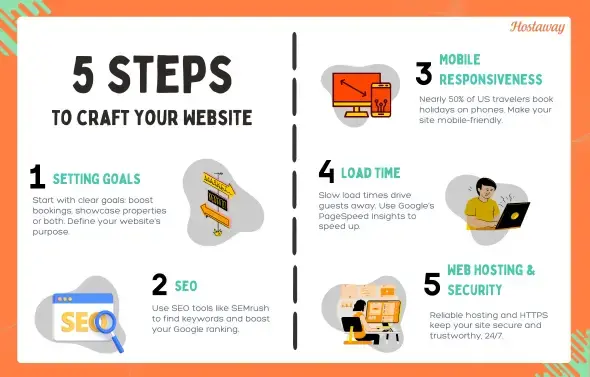How to Build a Vacation Rental Website

In today's digital age, having a dedicated website for your vacation rental isn't just a nice-to-have—it's essential. Think of it as your online real estate, a place where potential guests can find you, get to know your property and ultimately decide to book their stay with you. It's about standing out in a sea of listings and giving your vacation rental its own unique voice and space on the internet.
A dedicated website does wonders for enhancing visibility. It acts as your property's digital storefront, open 24/7, showcasing the best of what you have to offer. Through strategic SEO practices, your site can attract more eyeballs, drawing in guests who are searching for the perfect place to stay on their next vacation. It's about making your property visible to those who are actively looking, guiding them straight to your doorstep, so to speak.

Perks of Having Your Own website
While leveraging Airbnb and other Online Travel Agencies (OTAs) is beneficial for enhancing your property's visibility, it's not the be-all and end-all for your vacation rental business. Having your own website can significantly increase your profits and give you greater control over your bookings. Here’s how:
Maximize your earnings
Cut out commissions: OTAs take a slice of your earnings through commissions on every booking. These can quickly accumulate, especially with multiple properties or long-term bookings.
More profits: By funneling guests through your own website, you bypass OTA fees, retaining more revenue. Encouraging direct bookings from repeat guests or through referrals can further boost your margins.
Broad reach minus the middleman: While OTAs expand your market reach, integrating direct booking options offers the best of both worlds—wide visibility without forfeiting a portion of your income.
Unmatched control over guest experiences
Tailor-made bookings: OTAs dictate terms around communication, cancellations, and marketing. Your site means personalized booking experiences, special offers, and direct guest communication.
Stronger guest relationships: Direct interaction fosters trust and loyalty, allowing you to manage expectations and experiences from booking to checkout more effectively.
Presentation of Your property: Unlike the standardized listings on OTAs, your website can vividly showcase your property’s charm through high-quality images, unique selling points and even virtual tours.
Enhanced online presence: Use your website to gather guest reviews, share local insights through a blog, and integrate social media to attract and engage potential guests.
While OTAs play a crucial role in marketing your vacation rental, they shouldn't monopolize your strategy. Creating your own website not only saves you money on commissions but also grants you autonomy over the guest experience, offering a dual strategy for success in a competitive market. This approach not only improves profitability but also strengthens your brand identity, making your vacation rental more memorable and appealing to guests.
Planning Your Website

Setting goals
When diving into the website world for your vacation rental, kick things off by setting clear goals. What do you want your website to do for you? More direct bookings, flaunting your gorgeous properties, or maybe a mix of both? Putting down your goals on paper gives your site direction and purpose.
SEO
To get your vacation rental site noticed on Google, SEO is key. Don't worry if you're not a pro—tools like SEMrush can help you find the right keywords to get your site climbing the search ranks. Just sprinkle those keywords into your content, and help your site climb up Google search results.
Mobile responsiveness
At least 48% of people in the US say that they are comfortable booking an entire holiday on their phone. And that’s a big number. If your website is not responsive to the multiple devices at your customer’s disposal, you may be losing out on their business.
Load time
If your website loads slowly, you're gonna lose guests faster than you can say "welcome." Your website must load within 2 seconds and every extra second costs you, with a mere one-second delay slashing conversions by 7%. Want to speed things up? Google’s PageSpeed Insights is your go-to to pinpoint the slowdowns and get your site zipping along.
Website hosting and security
Reliable hosting is your website's foundation, keeping it accessible round the clock. Plus, securing your site with HTTPS isn’t just about protecting data, it tells your guests, "Hey, you can trust us." It’s like the digital version of locking the front door at night.
How to Build Your Vacation Rental Website
Figure out your domain
Domain name: Your domain is your web address, so pick something catchy yet simple, like your rental's name. Check if it's available on Google Domains, and decide between a .com or something local like .ca for Canada.
Grab your domain & hosting: Once you've landed on the perfect domain, register it with a reliable provider and secure hosting space. Providers like GoDaddy, Bluehost, or HostGator offer easy packages for both.
Choose your website builder
There’s more than one way to build your vacation rental website:
1. Use Hostaway’s Website Builder (Booking Engine Included)
Want a website that's both good-looking and easy to use, without needing a bunch of pages or complex menus with a direct booking system that syncs up seamlessly with Hostaway? Check out Hostaway's website builder. It's super user-friendly with zero tech skills required. You get responsive designs that work on any device, tons of cool templates, and it's fully customizable. You can even add an online store. And the best part? It's completely free for Hostaway users.
2. Use a Drag and Drop Builder
Building a website isn't rocket science anymore. It's way easier now with all those drag-and-drop builders out there. You just grab a template, plop in your content and photos, and voilà – you've got a website. Whether you're looking for something tailored for vacation rentals like Boostly or want to go with a general all-rounder like Squarespace, setting up your site is a breeze.
3. Get it Built by a Professional
If you can afford the higher budget and feel like nothing short of a professionally designed, 100% customized website experience will do for your vacation rental, you can always hire a professional to build your vacation rental website for you. This will allow you to showcase your brand to its fullest as everything is created from scratch though it may cost you an arm and a leg depending on who you hire.
What to Include in Your Vacation Rental Website
Booking engine: Adding a direct booking engine to your site lets guests book your place instantly, using filters like dates and amenities. It also makes managing reservations a breeze. For an easy setup, Hostaway provides widgets that easily integrate into your site.
Sleek interface: Keep your website design clean and sleek; visitors decide in less than 15 seconds if they'll stay. To avoid a high bounce rate, ensure it's uncluttered, easy to navigate, and meets users' needs.
Key pages: Your vacation rental website must have a booking engine, accommodation and amenities info, contact details, an about us page, FAQs, and a blog. Include social media links and ensure the content is engaging and reflects your brand.
Contacts: On your Contact Us page, provide full contact details and a form for easy access. Also, add a mobile number and email at the top of the page, with available contact hours.
High-quality photographs: Visuals are key—use high-quality photos to highlight your rental's luxury and uniqueness, showing what a great stay looks like.
Pricing: Make sure pricing is indicated clearly for the dates being searched, including fees, security deposits, etc, so guests are not left confused. Also clearly indicate any discounts you are providing, if any.
Special offers: Offer special packages from time to time, catering to couples during Valentine’s weekend or families during Christmas, as well as discounts, coupons, etc.
Experiences: List any Airbnb Experiences or activities if you offer them on a separate page. Consider bundling these with accommodations for special packages targeting niche travelers.
Testimonials: Collect your best reviews and feature them on your website. In the US 96% of potential guests rate reviews quite highly in helping them make their decision on which vacation rental to pick.
Terms and Conditions: Make sure you have a comprehensive terms and conditions document for your vacation rental which you can include in your website and even have guests ‘accept’ as part of the process of making their booking.
Why You Should List Your Vacation Rental Website on Google Vacation Rentals (GVR)
Google Vacation Rentals (GVR) offers an unparalleled opportunity to showcase your vacation rental to a massive audience directly through Google. By featuring your property on GVR, you tap into a vast pool of potential guests, bypassing the usual high commission fees of traditional booking sites. Hostaway emerges as a key player in this scenario, being one of the select platforms capable of seamlessly connecting your rental to GVR.